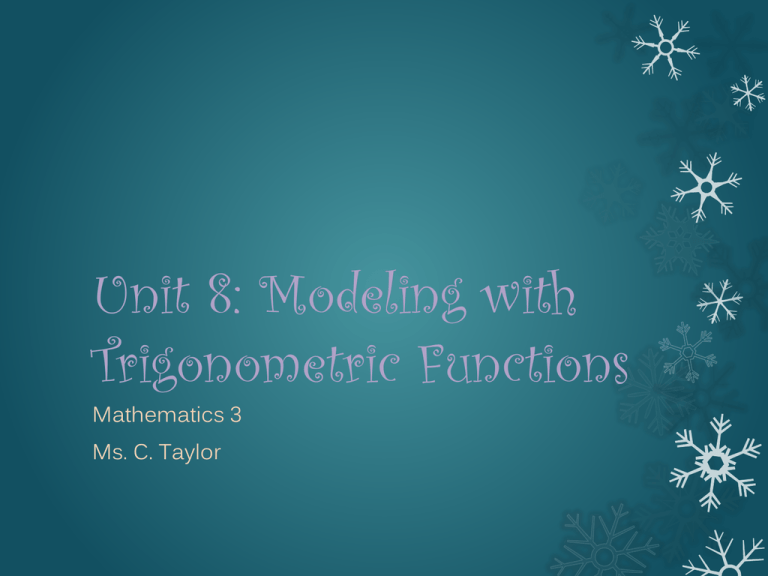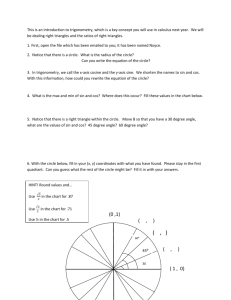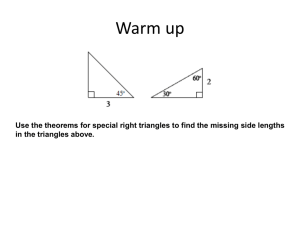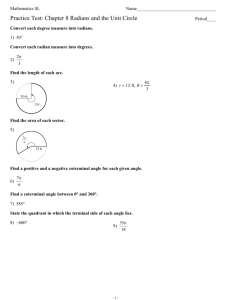
Unit 8: Modeling with
Trigonometric Functions
Mathematics 3
Ms. C. Taylor
Warm-Up
Solve the following:
𝑥−1
2𝑥
+
𝑥−3
𝑥
=
3
2
The ratios have names & abbreviations…
Ratio Name
sine
Abbreviation
sin
cosine
cos
tangent
tan
cotangent
secant
cosecant
cot
sec
csc
The Trigonometric (trig) ratios:
FUNCTION
INVERSE FUNCTION
Also true are…
In the ratios:
x is an angle (not the 90 degree angle)
“adjacent”, “opposite” and “hypotenuse” are all side
lengths, not angles
“Adjacent” is the side next to the known
angle
“Opposite” is the side across from the
known angle
!IMPORTANT!
To solve trig functions in the calculator,
make sure to set your MODE to DEGREES
Directions:
Press MODE, arrow down to Radian
Arrow over to Degrees
Press ENTER
Warm-Up
Measuring Angles
The measure of an angle is determined by the amount of
rotation from the initial side to the terminal side.
There are two common ways to measure angles, in degrees
and in radians.
We’ll start with degrees, denoted by the symbol º.
One degree (1º) is equivalent to a rotation of
revolution.
10
1
of one
360
Measuring Angles
Section 4.1, Figure 4.13, Common Degree
Measures on the Unit Circle, pg. 251
1
360
Copyright © Houghton Mifflin Company. All rights reserved.
Digital Figures, 4–9
Radian Measure
Definition of Radian:
One radian is the measure of a central angle
that intercepts arc s equal in length to the radius
r of the circle. Section 4.1, Figure 4.5, Illustration of
Arc Length, pg. 249
In general,
s
r
Copyright © Houghton Mifflin Company. All rights reserved.
Digital Figures, 4–6
Conversions Between Degrees and
Radians
1. To convert degrees to radians,
multiply degrees by
180
2. To convert radians to degrees,
multiply radians by 180
Ex 5. Convert the degrees to radian
measure.
a) 60
b) 30
c) -54
d) -118
e) 45
Ex 6. Convert the radians to
degrees.
a)
b)
c)
d)
6
2
11
18
9
Unit circle
Radius of the circle is 1.
x = cos(θ)
1 cos( ) 1
y = sin(θ)
1 sin( ) 1
Pythagorean Theorem: x 2 y 2 1
2
2
cos
(
)
sin
( ) 1
This gives the identity:
Zeros of sin(θ) are n where n is an integer.
Zeros of cos(θ) are
2
n
where n is an integer.
Warm-Up
Graphs of sine & cosine
f ( x) A sin( Bx C ) D
g ( x) A cos( Bx C ) D
Fundamental period of sine and cosine is 2π.
Domain of sine and cosine is .
Range of sine and cosine is [–|A|+D, |A|+D].
The amplitude of a sine and cosine graph is
|A|.
The vertical shift or average value of sine and
cosine graph is D.
2
The period of sine and cosine graph is B .
C
The phase shift or horizontal shift is B .
Sine graphs
y = sin(x)
y = 3sin(x)
y = sin(x) + 3
y = sin(3x)
y = sin(x – 3)
y = sin(x/3)
y = 3sin(3x-9)+3
y = sin(x)
Graphs of cosine
y = cos(x)
y = 3cos(x)
y = cos(x) + 3
y = cos(3x)
y = cos(x – 3)
y = cos(x/3)
y = 3cos(3x – 9) + 3
y = cos(x)
Tangent and cotangent graphs
f ( x) A tan( Bx C ) D
g ( x) A cot( Bx C ) D
Fundamental period of tangent and
cotangent is π.
x
|
x
n
Domain of tangent is 2 where n is an
integer.
Domain of cotangent x | x n where n is an
integer.
Range of tangent and cotangent is .
The period of tangent or cotangent graph
is .
B
Graphs of tangent and cotangent
y = tan(x)
Vertical asymptotes at
x
2
n .
y = cot(x)
Vertical asymptotes at
x n .
Graphs of secant and cosecant
y = sec(x)
Vertical asymptotes at
Range: (–∞, –1] U [1, ∞)
y = cos(x)
x
2
n .
y = csc(x)
Vertical asymptotes at
Range: (–∞, –1] U [1, ∞)
y = sin(x)
x n .
Warm-Up
Where did our Pythagorean identities come from??
Do you remember the Unit Circle?
What is the equation for the unit circle?
x2 + y2 = 1
• What does x = ? What does y = ?
(in terms of trig functions)
sin2θ + cos2θ = 1
Pythagorean
Identity!
Take the Pythagorean Identity and
discover a new one!
Hint: Try dividing everything by cos2θ
sin2θ + cos2θ = 1 .
cos2θ cos2θ cos2θ
tan2θ + 1 = sec2θ
Quotient
Identity
another
Pythagorean
Identity
Reciprocal
Identity
Take the Pythagorean Identity and
discover a new one!
Hint: Try dividing everything by sin2θ
sin2θ + cos2θ = 1 .
sin2θ sin2θ sin2θ
1 + cot2θ = csc2θ
Quotient
Identity
a third
Pythagorean
Identity
Reciprocal
Identity
Trigonometric Identities
Quotient Identities
sin
tan
cos
cos
cot
sin
Reciprocal Identities
1
sin
csc
1
cos
sec
1
tan
cot
Pythagorean Identities
sin2 + cos2 = 1
tan2 + 1 = sec2
cot2 + 1 = csc2
sin2 = 1 - cos2
tan2 = sec2 - 1
cot2 = csc2 - 1
cos2 = 1 - sin2
Simplifying trig Identity
Example1: simplify
tanxcosx
sin x
tanx cosx
cos x
tanxcosx = sin x
Simplifying trig Identity
Example2: simplify
sec x
csc x
1
cos
sec x
csc
1x
sin x
=
1
sinx
x
cos x
1
=
sin x
cos x
= tan x
Example
Simplify:
= cot x (csc2 x - 1)
Factor out cot x
= cot x (cot2 x)
Use pythagorean identi
= cot3 x
Simplify
Warm-Up
Types of Angles
There are four different types of angles in
any given circle. The type of angle is
determined by the location of the angles
vertex.
1. In the Center of the Circle: Central Angle
2. On the Circle: Inscribed Angle
3. In the Circle: Interior Angle
4. Outside the Circle: Exterior Angle
* The measure of each angle is determined
by the Intercepted Arc
Intercepted Arc
Intercepted Arc: An angle intercepts an arc if and only if
each of the following conditions holds:
1. The endpoints of the arc lie on the angle.
2. All points of the arc, except the endpoints, are in the
interior of the angle.
3. Each side of the angle contains an endpoint of the arc.
Central Angle
Definition: An angle whose vertex lies on the center of
the circle.
Central Angle
(of a circle)
Central Angle
(of a circle)
NOT A Central
Angle
(of a circle)
* The measure of a central angle is equal to the
measure of the intercepted arc.
Measuring a Central Angle
The measure of a central angle is
equal to the measure of its
intercepted arc.
123°
70°
28°
Inscribed Angle
Inscribed Angle: An angle whose vertex lies on a circle and
whose sides are chords of the circle (or one side tangent to
the circle).
Examples:
1
3
2
No!
Yes!
4
No!
Yes!
Measuring an Inscribed Angle
The measure of an inscribed angle is
equal to half the measure of its
intercepted arc.
82°
Corollaries
If two inscribed angles intercept the
same arc, then the angles are
congruent.
Corollary #2
An angle inscribed in a semicircle is a right
angle.
Corollary #3
If a quadrilateral is inscribed in a circle,
then its opposite angles are
supplementary.
88
82°
98°
92°
** Note: All of the
Inscribed Arcs
will add up to 360
Warm-Up
Area of a Sector Formula
measure of the central angle or arc
Area of a sector =
m
2
πr
360
The area of the entire circle!
The fraction of the circle!
.
6. The area of sector AOB is 48π and mAOB 270. Find the radius of ○O.
Area of a sector =
m
πr2
360
270
48π =
πr2
360
4 16 3
4
48 =
r2
3
4
3
64 =
r2
r=8
9
and mAOB 40 . Find the radius of ○O.
7. The area of sector AOB is
4
Area of a sector =
m
πr2
360
9
40
π=
πr2
4
360
99 1 2 9
=
r
1 4 9
1
81 2
= r
4
r= 9
2
The standard form of the equation of a
circle with its center at the origin is
x y r
2
2
2
r is the radius of the circle so if we take the square root of the right
hand side, we'll know how big the radius is.
Notice that both the x and y terms are squared. Linear equations don’t have
either the x or y terms squared. Parabolas have only the x term was squared
(or only the y term, but NOT both).
Let's look at the equation
x y 9
2
2
This is r2 so r = 3
The center of the circle is at the origin and the radius is 3. Let's
graph this circle.
Count out 3 in all
directions since that is
the radius
Center at (0, 0)
-7 -6 -5 -4 -3 -2 -1 0 1 2 3 4 5 6 7 8
If the center of the circle is NOT at the origin then the equation for the
standard form of a circle looks like this:
x h y k
2
2
r
This is r2 so r = 4
The center of the circle is at (h, k).
x 3 y 1
2
2
2
16
Find the center and radius and graph this circle.
The center of the circle is at (h, k) which is (3,1).
The radius is 4
- - - - - - 7 6 5 4 3 2 10
12345678
If you take the equation of a circle in standard form for example:
x 2 y 4
2
2
4
This is r2 so r = 2
(x - (-2))
Remember center is at (h, k) with (x - h) and (y - k) since
the x is plus something and not minus, (x + 2) can be
written as (x - (-2))
You can find the center and radius easily. The
center is at (-2, 4) and the radius is 2.
But what if it was not in standard form but multiplied out (FOILED)
x 4 x 4 y 8 y 16 4
2
2
Moving everything to one side in descending order and combining like terms we'd
have:
x y 4 x 8 y 16 0
2
2
x y 4 x 8 y 16 0
2
2
If we'd have started with it like this, we'd have to complete the square on both the x's
and y's to get in standard form.
Group x terms and a
Group y terms and a
place to complete the place to complete the
square
square
Move
constant to
the other side
2
4
16 16 ___
4 ___
16
x 4 x ____ y 8 y ____
2
Complete the square
Write factored and wahlah! back in standard form.
x 2 y 4
2
2
4
Warm-Up
Warm-Up
Law of Sines & Law of
Cosines
Law of sines
Law of cosines
sin( A) sin( B) sin( C )
a
b
c
a
b
c
sin( A) sin( B) sin( C )
c 2 a 2 b 2 2ab cos(C )
Use when you have a
complete ratio: SSA.
b 2 a 2 c 2 2ac cos( B)
a 2 b 2 c 2 2bc cos( A)
Use when you have SAS, SSS.







